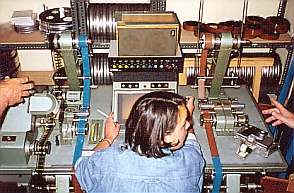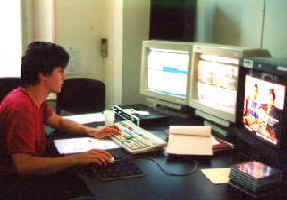TO KILL A MOCKINGBIRD: SEEING THE FILM THROUGH THE LENS OF MEDIA LITERACY
© 2006 Frank Baker
download this page as an Adobe (pdf) document
|
|
|
What is editing? Why is editing important? Do most students know that films are shot out-of-order? After photography is completed on a film, the work of the editor can begin. But what does an editor do? What guides his/her decisions? How does an editor learn this skill?
These, and other questions, might be considered by your students as they start to understand the role and function of the film editor. Here is some background:
To an editor, everything that happens during the production process is merely the creating and collecting of raw materials that the editor,
with great skill and artistry, will make into a viable film or video. The editor is the one who ultimately creates the production……The editor has to
analyze the given material and make intellectual and aesthetic decisions that will result in the finished work.” 1
“Aaron Stell’s editing (on To Kill A Mockingbird ), carrying out the fluid design of director and cameraman, moves forward without apparent pace, but inexorably.”2
“In the editing process, the editor does not usually attempt to create an exact record of what happened as viewed through the eyes of one
character. Rather, the editor–in collaboration with the director and in keeping with the vision of the writer–must ‘translate’ the events
of each scene into the most effective images, placing each one in the order and length most appropriate to telling the story. Timing
is indeed everything for the editor.
One approach to editing is continuity. Continuity editing generally represents the action in a logical, chronological sequence. Even though
the time and space of a sequence may be manipulated, it has the appearance of ‘real’ time to the viewer. A long shot of a person sitting
down is ‘matched’ to a close-up of the person sitting down into the frame. In essence, the editor is focusing in on the scene in much the same manner
as the human eye–jumping from place to place, farther or closer. In actuality, the action appears more natural if two or three frames are deleted by the editor at the splice.”3
One of the tools of the film editor is the actual edit itself. An editor must decide whether to “cut” from one scene to the next or whether to “dissolve,” in which one scenes slowly fades into another scene. What are the differences and why would an editor use one over another?
Editing: Cut: The cutting apart of 2 shots at the frameline, or the point where the shots have been cut apart.4
Editing: Dissolve: a transition between two shots, where one shot fades away and simultaneously another shot fades in.4
DVD Chapter 10 ” A Look At Boo” Running Time 23:45
The scene to notice here starts at 25:13: Notice how the frame slowly dissolves between the shot of the house, to the shot of the kids approaching the house. Here a dissolve indicates the passage of time, and change of location.
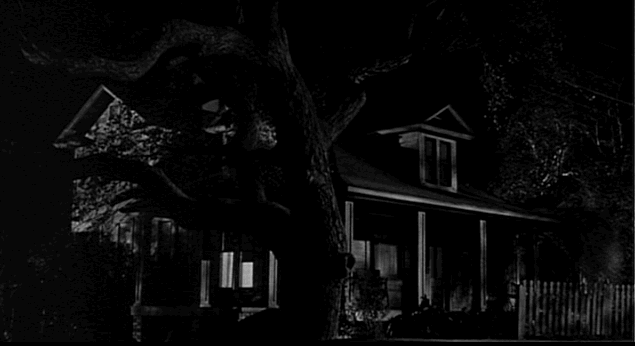
1 we see the house in a static shot
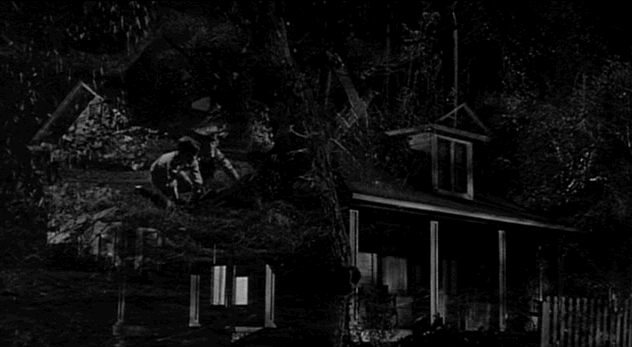
2 the dissolve begins: and we can see the children slowly
begin to appear in the left center middle of the frame
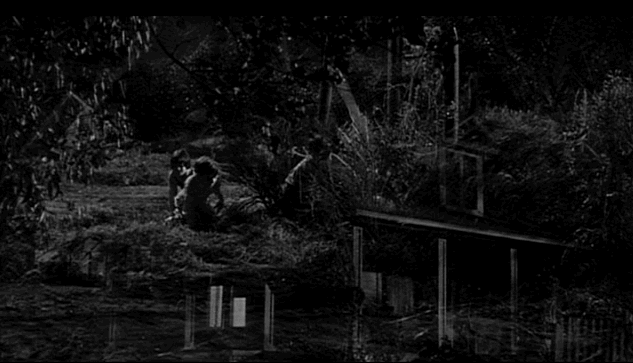
3 the house is now hardly visible; as the scene with the
children is revealed a bit more
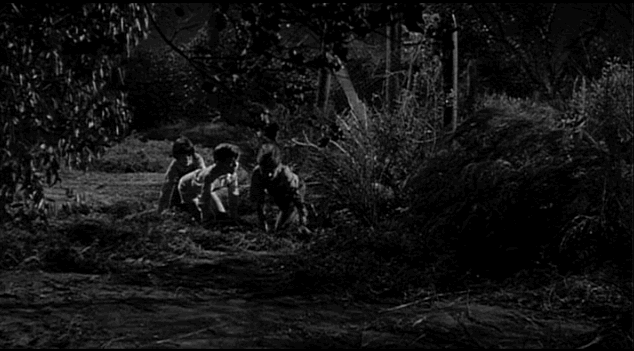
4 the dissolve is complete: now we see the entire setting
of the children approaching the back of the Radley house
(the entire dissolve lasts only 5 to 6 seconds)
DVD Chapter 34 “Death In The Dark” Running Time 1:54:55
In this scene, students will be asked to notice how a scene is edited. This is an intense scene, in which the children, heading home through the woods at night, are attacked by an unknown assailant, who we later learn to be Bob Ewell. Music is an important element, but it is the chosen shots (by the cinematographer) and the editing that are worthy of study and analysis. Notice how quickly the scenes are cut, thus increasing the pace of the scene. Some shots last just a few seconds, not giving your brain an opportunity to comprehend what is happening to Jem, Scout, the assailant, or the person who eventually fights the assailant, who we later learn to be Boo Radley.
“During the dénouement (after the climatic trial) Scout is dressed as a ham on her way to a school function. When Jem is attacked Scout is unable see everything that is going on. Likewise, the audience is forced to view the attack from Scout’s point of view. The montage of shots confuses the moment and emphasizes the difficulty of comprehending reality when the entire picture isn’t clear.” 5
Teaching suggestion: have students take on the roles of directors, cinematographers and editors. In groups, they have to design this scene. They have to decide where the cameras are positioned, and how the scene will be shot. Using blank storyboard sheets, and a storyboard organizer, they draw the scene, after which they explain it to the class. (Other classes may decide, with the proper equipment, to re-enact the scene and to videotape
and edit it)
Recommended Links
Film Analysis (see editing) http://classes.yale.edu/film-analysis/
Film Language: Use of Editinghttp://www.filmeducation.org/secondary/concept/filmlang/docs/lang7.html
Putting the Pieces Together: What Does It Mean to Edit a Movie?http://scenariosusa.org/educators/makingmovies/ch5.pdf
Film Editing Glossary http://www.learner.org/exhibits/cinema/editing2.html
Film/Editing Terms http://www.zerocut.com/tech/film_terms.html
A Glossary of Film Terms
http://homepage.newschool.edu/~schlemoj/film_courses/glossary_of_film_terms/glossary.html
Recommended Readings
Film Editing: A Hidden Art? http://imv.au.dk/publikationer/pov/Issue_06/section_1/artc2A.html
Film editing (history) http://www.factmonster.com/ce6/ent/A0859784.html
Film Editing http://www.filmmakers.com/features/editing/
Introduction to Film Editing (Lesson Plan) http://www.thirteen.org/edonline/lessons/editing/b.html
Recommended Video/DVD
The Cutting Edge: The Magic of Movie Editing
Recommended Texts
Cinema Editor Magazine http://www.ace-filmeditors.org/news.htm
Points of View: Three Hollywood Film Editors Discuss Their Art
The Conversations: Walter Murch and the Art of Editing Film, Michael Onda
Film Editing: The Art of the Expressive, Valerie Orpen
Film Art: An Introduction, David Bordwell, Kristin Thompson
First Cut: Conversations with Film Editors, Gabriella Oldham
In The Blink of an Eye, Walter Murch, Francis Ford Coppola
Key Concepts in Cinema Studies, Susan Hayward
The Technique of Film Editing, Karel Reisz, Gavin Millar
When the Shooting Stops, The Cutting Begins: A Film Editor’s Story
Ralph Rosenblum and Robert Karen



